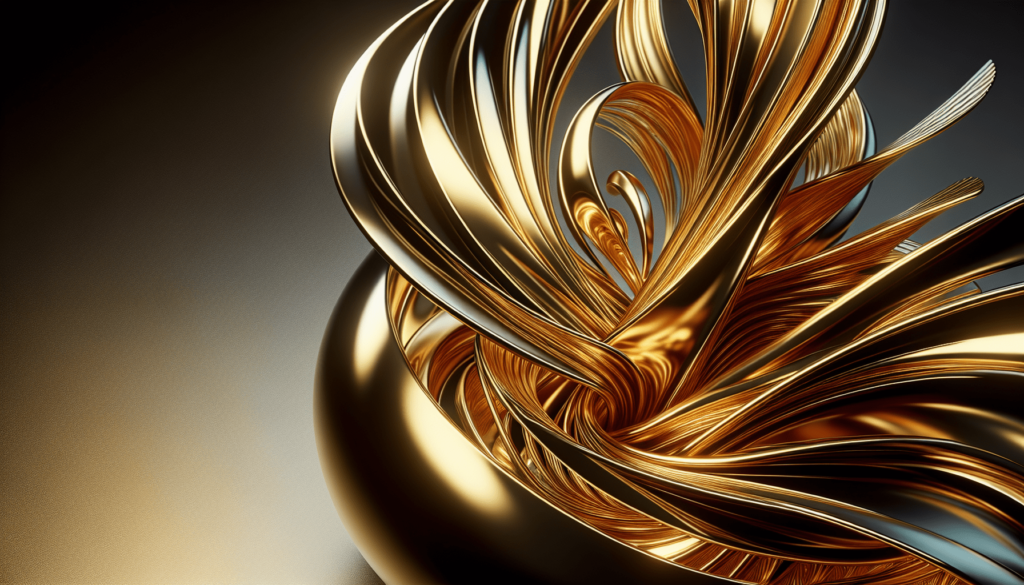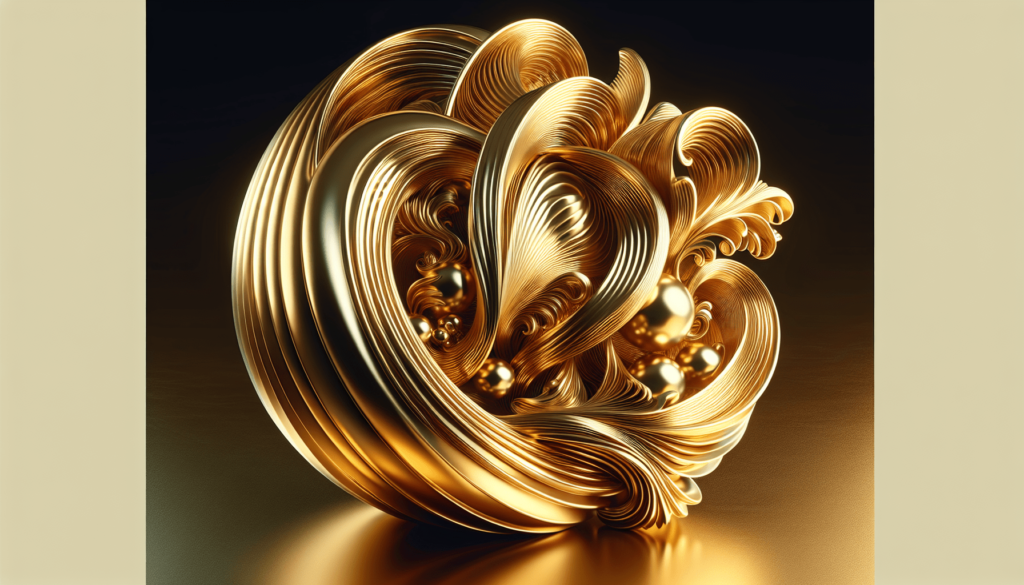Welcome to the fascinating world of modern sculpture and fine art, where the use of gold has long been a symbol of luxury, prestige, and opulence. The incorporation of gold in artworks has been a source of inspiration for countless artists throughout history, elevating their pieces to new heights of beauty and extravagance. From ancient civilizations to contemporary artists, the allure of gold continues to captivate and adorn exquisite sculptures and paintings, enhancing their aesthetic appeal and cultural significance. Join us on a journey as we explore the timeless influence of gold in modern art and sculpture, and discover the magic it brings to the world of creativity and imagination. Have you ever wondered about the role of gold in modern sculpture and fine art? From ancient civilizations to contemporary artists, gold has held a special place in the world of art. Let’s explore how gold has influenced modern sculpture and fine art and why it continues to captivate artists and viewers alike.

The History of Gold in Art
Gold has been used in art for centuries, dating back to ancient civilizations such as Ancient Egypt, Mesopotamia, and the Roman Empire. In these early cultures, gold was highly prized for its rarity, beauty, and association with wealth and royalty. Artists used gold to create intricate jewelry, religious artifacts, and decorative objects, showcasing the metal’s enduring appeal in the world of art.
Gold in Ancient Sculpture
In ancient sculpture, gold was often used to adorn statues of gods, pharaohs, and other important figures. The shimmering gold accents added a sense of luxury and opulence to the sculptures, capturing the attention of viewers and conveying the power and status of the subjects. Gold leaf was also commonly used to decorate architectural elements, such as columns and friezes, creating a sense of grandeur and magnificence in ancient buildings.
The Symbolism of Gold in Art
Gold has long been associated with wealth, power, and divinity in various cultures around the world. In many societies, gold is believed to possess magical or spiritual properties, making it a symbol of purity, enlightenment, and eternal life. Artists often use gold in their works to convey these symbolic meanings and evoke a sense of awe and reverence in the viewer.
Gold as a Symbol of Wealth and Status
In art, gold is often used to symbolize wealth, prosperity, and social status. The use of gold leaf or gold paint in a painting or sculpture can elevate the subject matter and convey a sense of luxury and extravagance. Artists may use gold to highlight certain elements of their work, such as a figure’s clothing or accessories, to emphasize the opulence and grandeur of the scene.
Gold as a Symbol of Divinity and Spirituality
In many religious traditions, gold is considered a sacred metal that represents the divine and the spiritual realm. Artists often use gold to depict religious figures, symbols, and narratives, imbuing their work with a sense of holiness and transcendence. The radiant glow of gold can evoke a sense of awe and wonder in the viewer, inviting them to contemplate the mysteries of the universe and the divine.
Techniques for Using Gold in Sculpture and Fine Art
There are several techniques for using gold in sculpture and fine art, each with its own unique qualities and effects. Whether as a decorative element or a central focus of the artwork, gold can be applied in various ways to achieve different aesthetic and symbolic outcomes.
Gold Leaf
One of the most common methods of incorporating gold into art is through the use of gold leaf. Gold leaf is made by hammering gold into thin, delicate sheets that can be applied to a surface with adhesive. Artists can use gold leaf to gild sculptures, paintings, and other objects, adding a luminous sheen and depth to their work. The delicate nature of gold leaf requires precision and skill to apply, but the results can be breathtakingly beautiful.
Gold Paint
Another popular technique for using gold in art is through the use of gold paint. Gold paint is typically made by mixing powdered gold or other metallic pigments with a binding agent, such as oil or acrylic. Artists can use gold paint to add metallic accents and highlights to their work, creating a sense of richness and warmth in their compositions. Gold paint can be applied with a brush, palette knife, or other tools to achieve different textures and effects, making it a versatile medium for artists to explore.
Gold Plating
For sculptors and metalworkers, gold plating is a technique that involves applying a thin layer of gold to a metal surface through a process of electrolysis or electroplating. Gold plating can be used to create sculptures, jewelry, and other objects with a durable and long-lasting gold finish. The reflective quality of gold plating can enhance the visual impact of a piece, adding depth and dimension to the surface and creating a sense of brilliance and radiance.
Contemporary Artists Using Gold in Sculpture and Fine Art
In the world of contemporary art, many artists continue to explore the use of gold in their work, pushing the boundaries of traditional techniques and materials to create innovative and groundbreaking pieces. From large-scale installations to intimate sculptures, gold remains a versatile and engaging medium for artists to experiment with and express their creative vision.
Anish Kapoor
British-Indian sculptor Anish Kapoor is known for his large-scale sculptures and installations that explore themes of identity, spirituality, and the sublime. Kapoor often uses gold leaf in his work to create mirror-like surfaces that reflect and distort the viewer’s image, inviting them to contemplate their own existence and place in the world. The luminous quality of gold adds a sense of transcendence and mystery to Kapoor’s sculptures, drawing viewers into a meditative and reflective space.
Yayoi Kusama
Japanese artist Yayoi Kusama is renowned for her immersive installations and sculptures that explore themes of infinity, obsession, and self-obliteration. Kusama often incorporates gold into her work through the use of gold leaf, metallic paints, and reflective surfaces that create a dazzling and kaleidoscopic effect. The radiant glow of gold in Kusama’s art adds a sense of magic and wonder to her psychedelic and surrealistic creations, inviting viewers to lose themselves in a world of infinite possibilities.
Damien Hirst
British artist Damien Hirst is known for his provocative and controversial artworks that challenge the boundaries of taste, morality, and commercialism. Hirst often incorporates gold into his sculptures and paintings to critique the art market and the commodification of creativity. The use of gold in Hirst’s work adds a sense of irony and excess, highlighting the absurdity and decadence of the art world. By subverting traditional notions of value and worth, Hirst invites viewers to question the role of gold in contemporary society and art.

Gold’s Impact on the Viewer
The inclusion of gold in sculpture and fine art can have a powerful impact on the viewer, eliciting a range of emotions and responses that can shape their perception of the artwork and the artist’s intent. Whether used as a decorative element or a central motif, gold has the ability to captivate and mesmerize viewers, drawing them into the world of the artwork and inviting them to participate in a sensory and intellectual experience.
Awe and Wonder
The radiant glow and luster of gold can evoke a sense of awe and wonder in the viewer, creating a sense of magic and enchantment that transcends the physical world. The shimmering quality of gold can capture and reflect light in mesmerizing ways, enchanting the viewer and inviting them to explore the intricacies and nuances of the artwork. The presence of gold can elevate the mundane to the extraordinary, transforming everyday objects and scenes into objects of beauty and desire.
Status and Luxury
The use of gold in art can convey a sense of status and luxury, signaling to the viewer the wealth and opulence of the subject matter. Gold’s association with power and prestige can imbue a sense of grandeur and extravagance in the artwork, elevating the viewer’s perception of the artist’s skill and vision. The inclusion of gold can create a sense of exclusivity and allure, drawing viewers into the world of the artwork and inviting them to indulge in the pleasures of beauty and sophistication.
Spiritual and Transcendent
For many viewers, gold in art can evoke a sense of spirituality and transcendence, opening up a window into the mysteries of the cosmos and the divine. The radiant glow and purity of gold can symbolize enlightenment and purity, inviting viewers to contemplate their place in the universe and the interconnectedness of all beings. The presence of gold in art can create a sense of serenity and serenity, inviting viewers to reflect on the eternal truths and truths of existence.
Conclusion
In conclusion, gold has played a significant role in the world of modern sculpture and fine art, influencing artists and viewers alike with its beauty, symbolism, and versatility. From ancient civilizations to contemporary artists, gold has captured the imagination and inspired creativity in countless ways, shaping the evolution of art and culture. Whether used as a decorative element or a central focus, gold continues to captivate and intrigue audiences, inviting them to explore the mysteries and wonders of the world through the transformative power of art.

